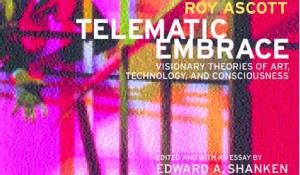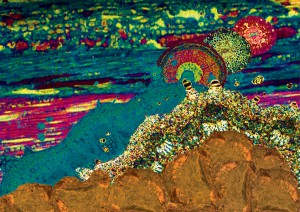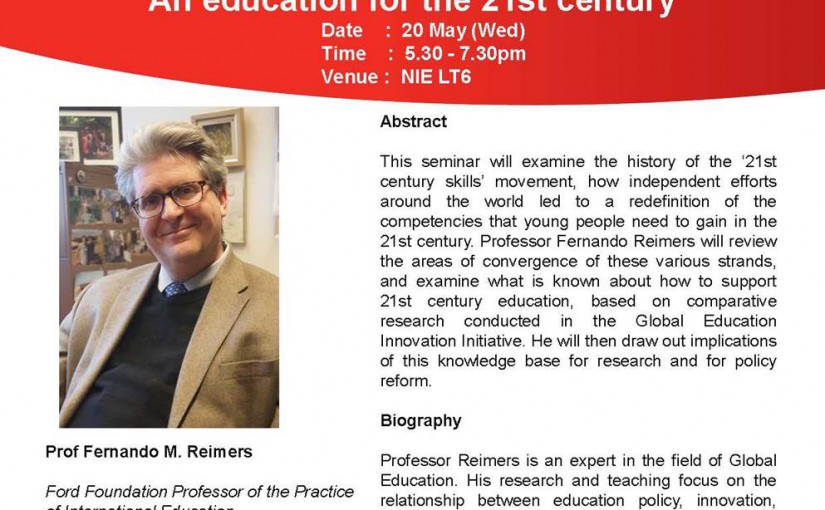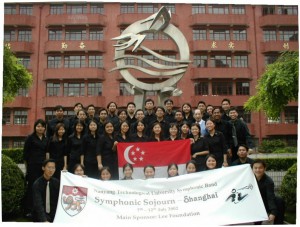
The Gap Between the Affordances of OSS vs User’s Ontological and Epistemic Beliefs of Art
Borrowing from Maturana and Francisco (1987, cited in Ascott, 1990), it is abundantly clear that technologies such as OSS have the potential to engender the epistemological, ontological, and axiological shift to the contemporary notion of “art as residing in a cultural communications system rather than in the art object as a fixed semantic configuration—a system in which the viewer actively negotiates for meaning” (p. 241).
I believe that OSS can facilitate this epistemic shift that Ascott advocates. However, from reading several posts, it is obvious that a number of OSS users are not harnessing or embracing the full potential of the telematic wonder that is OSS, from the manner in which they primarily upload and share content, rather than challenge one another to rethink their beliefs and experiment with alternative processes of visual representation and expression. The share and comment or show and tell nature of their posts indicate that they may be unreflexively perpetuating the classical communications notion of the artist as one-way dispatcher or sender, progenitor, creator, owner, arbiter, controller of images and ideas, context and content, by merely expecting the viewer to decode or interpret the artist’s intentions and meaning—as the GCE Advanced Level art syllabus regrettably advocates.
This transmissionist view of learning in the visual arts and to a wider of extent, of learning (about, rather than learning by doing or through performance) in general, assumes that the beauty and truth of both art and the world—as fixed and immutable—are “out there” in the world and in the work of art (Ascott, 1990, p. 242). This stubborn view of learning as content transmission is highly problematic, if OSS users still adhere to the old GCE A level way to thinking, where “learning” is evinced by content creation and transmission. Just as you can’t learn swimming by learning about swimming through books and videos, you can’t learn art by learning about it through merely transmitting content for viewers to decode.
The key problem lies with the representational nature of the medium that limits learning to a two dimensional virtual plane, for one cannot learn purely through viewing images and responding to posts or comments. If OSS is merely used for content sharing (as one the design students apparently did by documenting her design process), OSS users must be fully cognizant of the fact that content has simply been transmitted through a new medium—from carbon on paper, to pixels on screen, albeit through a sleek interface; the thinking or epistemic belief is still undergirded by slavish notions of schooling (as opposed to educating) or “learning about”.
We are nowhere was a perfect example of how Adobe Connect as a representational medium, to cross out “observer” and replace it with “participator”, and in doing so make the third space a participatory universe (John Wheeler, cited in Ascott, 1990, p. 242). The connection that Ascott makes between art and quantum mechanics, recontextualizes learning in the third space, by shifting the focus from content to meaning, or from data to quanta. Learning telematic art by doing or through performance was evident here, rather than learning about it.
Now, if only there were more opportunities for such collaboration, that could be incorporated into the enacted curriculum. Must the undergraduate OSS artists work solo for the purpose of assessment, all the time? Could there be one aspect of the assessment that rewards students for sustained collaboration and peer critique? I am thinking aloud, how OSS modules can be more collaborative, so that the full potential of this telematic medium is pushed to its limits.
There is no such thing as the “mind”!
I am troubled by Ascott’s repeated use of the “mind”, which can be traced to the Descartian notion of the body and mind as separate entities. I would have used person or artist or viewer, rather than mind. Why does Ascott (1990) insist that the whole (in the context of the telematic network) is greater than the sum of its parts (p. 243), and yet assume that the mind and be decoupled from the person? Speaking about the “mind” makes no sense to me. The “mind” exists through language, and does not have the ontological existence that say the brain or the body has. Similarly, I can show you the NTU swimming pools and lecture theatres, but I cannot “show” you the university, because the “university” comes into existence through the language. Language can create something out of nothing, just as the mind was created when there is no such thing!
Where is the mind? If indeed it is in the brain, as most would argue, then which specific area of the brain does the putative mind reside? Will a dissected brain show where precisely the mind resides? If the mind resides in some part of the brain, what controls it? Those who posit that a little green homunculus controls the mind, then imply that the homunculus is in turn controlled by his mind, containing another homunculus controlling it, thus engendering an infinite regress.
This problem can be traced to Descartian philosophy that assumes the mind and body can be decoupled, to represent the inner mental world (ie. the putative mind) and the outer world (or “reality”) where “true” knowledge resides. However, the mind and body are but one coupled entity. It makes no sense to isolate the mind, and talk about the mind, as if it functions independently of the brain or person. Does the mind think? You see, when presented with a grammar cloze “______ thinks”, what would you fill into the blank, before the verb “thinks?” Alvin’s mind thinks? Nay, it should be “Alvin thinks” or “He thinks”!
This false dualism engenders the erroneous notion that knowledge is passive, unchanging or static and that learning therefore entails “acquiring” (input) and processing this objective reality into the learners’ putative internal store or memory. By the same logic, “learning” is therefore evinced by “output” or transmission of content. This cognitivist model of learning is patently wrong, as the typical learner sees the world beyond the classroom as more than just consisting of say, trees and people, but of leaves and branches swaying in the breeze, and people crossing the road—in other words, in constant dynamic motion or change, not a static photograph, as suggested by cognitivist models of learning.
The widespread materialist cognitivistic conviction even amongst art educators and educational technologists that human cognition (and hence learning) can be reduced to an overly simplistic metaphor of the input-process-output model of the computational theory of the mind, is fundamentally and dangerously flawed, as it mistakenly assumes that there exists an “internal” and “external” environment, and that this external reality should then consequently be “correctly” represented in the “mind” as “true knowledge” (Chee, 2011, p. 100), giving rise to an ontological dualism.
What then of learning, which is itself an unobservable phenomenon, that materialists seek to “internalize” into a putative internal store. Even Vygotsky made the mistake of problematically using the term “internalize” (L. Smith, Dockrell, & Tomlinson, 1997), implying that the external and internal worlds are different, and that the task of the teacher or artist is to transmit the outer physical reality into the inner mental world of the learner or viewer, as the Nurnberg Funnel suggests, because knowledge cannot be funnelled into our learners or viewers — for “knowing” is a process in which learners have to participate actively. Knowledge is therefore not in the “mind” as widely and mistakenly believed, and is thus not taken from the external world to be internalized or put into the “mind”. Learners do not simply “acquire” what is written onto the blackboard or screen, rather, the reverse is true—the learner often thinks of an idea that is subsequently re-presented or written onto the blackboard.
To illustrate my point, I shall cite Ms Diana Toh’s final year project and performance. The raw emotion that spilled onto the black canvas during her performance evinced learning by doing in the most visceral and eviscerating manner. There was no external pain that she acquired and input into a putative store or memory that she could simply output during the performance. Learning was evinced by a dynamic performance or by doing, as opposed to her static images and videos uploaded to her OSS site.
Interestingly, Randall’s comments on Diana’s project about transcending the physical to the virtual world, did not see any response from Diana or from her peers. I would have loved to see a sustained dialogue between Randall, Diana and her peers. I gather that this dialogue probably occurred face to face, e-mail and through other modalities not captured on OSS. Clearly WordPress is only one out of a range of modalities used in the module, so it would be unrealistic to expect OSS to capture all the exchanges between users.
The Love in The Telematic Embrace Still Ain’t Deep Enough
I believe that there is still room for more love in the telematic embrace of OSS, in the form of robust exchange, dialogue, and debate between OSS users, if Ascott’s (1990) vision of the power of the interface to shape language and thought (p. 243), is to be realized. Cross pollination and development of ideas should ideally occur between users, and not purely between tutor and student, as is currently often the case. The design or developmental trajectory appears to be dominated by student and tutor, with the occasional pleasant perfunctory fleeting comment by fellow undergraduates.
To facilitate vigorous exchange, decentralized authorship, and active participation in joint meaning-making as Ascott advocates, there must be an authentic purpose for learners to engage in peer critique, although my experience as an art teacher indicates that Singaporean students often confuse peer critique with criticism, and therefore shy away from openly challenging other users’ ideas. Netzley and Rath (2012) faced considerable difficulty getting SMU undergraduates to debate one another openly on their wiki space, as the desire to “save face” meant that Singaporean students avoided correcting perceived errors and debating their peers online, for dong so would leave a permanent record of their critique or “criticisms” in the virtual world.
I suppose as with any emergent educational technology, time for students to build trust, and for tutors to realign assessment to the curriculum is imperative (Yan, 2015), for it would be futile to expect users to buy into the new affordances of OSS, when assessment modes and habits remain unchanged. Perhaps, this would compel reluctant learners stuck in the transmissionist GCE A level mode of thinking, to embrace OSS that offers a new approach to learning by harnessing the “global brain” that Peter Russell (1982, cited in Ascott, 1990, p. 242) envisions. I see the potential for OSS to profoundly shift epistemic beliefs of art and learning.
Perhaps the key task is to identify issues and concerns that resistant users face, in doing so. I must speak to more users, and tutors, to explore the push and pull factors that hinder and facilitate OSS adoption. This is necessary, for while I may wish to “light the fire”, I certainly do not want users to feel forced to adopt OSS because of performative pressures. I suppose I need to break away from the carrot and stick approach to technology adoption, that is used on MOE teachers.
References
Ascott, R. (1990). Is there love in the telematic embrace? Art Journal, 49(3), 241.
Chee, Y. S. (2011). Learning as becoming through performance, play and dialogue: A model of game-based learning with the game Legends of Alkhimia. Digital Culture & Education, 3(2), 98-122.[1987] 1992.
Maturana, H. R., & Varela, F. J. (1987). The Tree of Knowledge: The Biological Roots of Human Understanding. Translated by Robert Paolucci. Rev. ed. Boston: Shambhala
Netzley, M. A., & Rath, A. (2012). Social Networks and the Desire to Save Face: A Case From Singapore. Business Communication Quarterly, 75(1), 96-107. doi: 10.1177/1080569911433434
Smith, L., Dockrell, J., & Tomlinson, P. (1997). Piaget, Vygotsky, and beyond : future issues for developmental psychology and education. London ; New York: Routledge.
Yan, C. (2015). ‘We can’t change much unless the exams change’: Teachers’ dilemmas in the curriculum reform in China. Improving Schools, 18(1), 5-19. doi: 10.1177/1365480214553744




